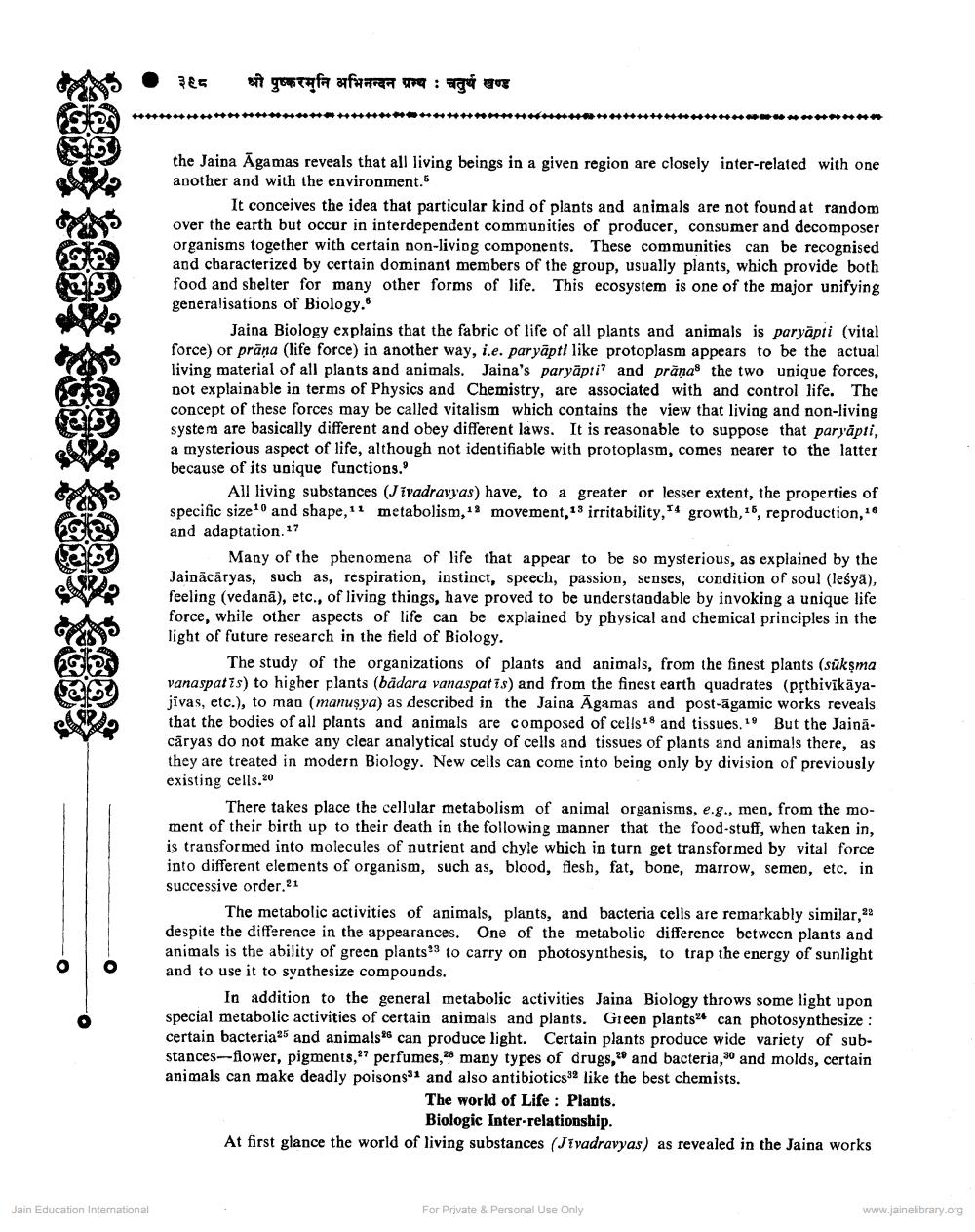________________
O
O
Jain Education International
३६८
श्री पुष्करमूनि अभिनन्दन ग्रन्थ : चतुर्थखण्ड
the Jaina Agamas reveals that all living beings in a given region are closely inter-related with one another and with the environment.5
It conceives the idea that particular kind of plants and animals are not found at random over the earth but occur in interdependent communities of producer, consumer and decomposer organisms together with certain non-living components. These communities can be recognised and characterized by certain dominant members of the group, usually plants, which provide both food and shelter for many other forms of life. This ecosystem is one of the major unifying generalisations of Biology."
Jaina Biology explains that the fabric of life of all plants and animals is paryāpti (vital force) or prāna (life force) in another way, i.e. paryapti like protoplasm appears to be the actual living material of all plants and animals. Jaina's paryapti and praṇas the two unique forces, not explainable in terms of Physics and Chemistry, are associated with and control life. The concept of these forces may be called vitalism which contains the view that living and non-living system are basically different and obey different laws. It is reasonable to suppose that paryapti, a mysterious aspect of life, although not identifiable with protoplasm, comes nearer to the latter because of its unique functions."
All living substances (Jivadravyas) have, to a greater or lesser extent, the properties of specific size10 and shape, 11 metabolism, 12 movement, 13 irritability, 14 growth, 15, reproduction,16 and adaptation. 17
Many of the phenomena of life that appear to be so mysterious, as explained by the Jainācāryas, such as, respiration, instinct, speech, passion, senses, condition of soul (leśya), feeling (vedana), etc., of living things, have proved to be understandable by invoking a unique life force, while other aspects of life can be explained by physical and chemical principles in the light of future research in the field of Biology.
The study of the organizations of plants and animals, from the finest plants (sūkṣma vanaspatis) to higher plants (badara vanaspatis) and from the finest earth quadrates (prthivīkāyajīvas, etc.), to man (manusya) as described in the Jaina Agamas and post-agamic works reveals that the bodies of all plants and animals are composed of cells 18 and tissues. 19 But the Jainacāryas do not make any clear analytical study of cells and tissues of plants and animals there, as they are treated in modern Biology. New cells can come into being only by division of previously existing cells.20
There takes place the cellular metabolism of animal organisms, e.g., men, from the moment of their birth up to their death in the following manner that the food-stuff, when taken in, is transformed into molecules of nutrient and chyle which in turn get transformed by vital force into different elements of organism, such as, blood, flesh, fat, bone, marrow, semen, etc. in successive order.21
The metabolic activities of animals, plants, and bacteria cells are remarkably similar, 22 despite the difference in the appearances. One of the metabolic difference between plants and animals is the ability of green plants23 to carry on photosynthesis, to trap the energy of sunlight and to use it to synthesize compounds.
In addition to the general metabolic activities Jaina Biology throws some light upon special metabolic activities of certain animals and plants. Green plants24 can photosynthesize : certain bacteria25 and animals26 can produce light. Certain plants produce wide variety of substances-flower, pigments," perfumes,28 many types of drugs, and bacteria,30 and molds, certain animals can make deadly poisons31 and also antibiotics32 like the best chemists.
The world of Life: Plants. Biologic Inter-relationship.
At first glance the world of living substances (Jivadravyas) as revealed in the Jaina works
For Private & Personal Use Only
www.jainelibrary.org




